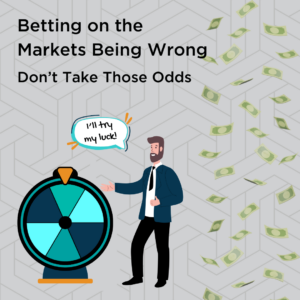Capitalizing on Market Mispricing is Easier Said than Done

By Steve Lowrie, CFA
Special to Financial Independence Hub
A common refrain in investing is that news and expectations are already “priced in.”
I often say this publicly and in individual client meetings. When clients are concerned about changes in the market and want to act on what they are hearing, I remind them that the market is ahead of the media rumblings and that snap financial decisions tend to sabotage positive financial outcomes.
So, it is much better to hold firm with your investment strategy, which should be based on a sound financial plan, rather than reactively sell, because those who react are most likely reacting too late.
And I’m not just guessing. I’m advising based on my experience and deep understanding of how markets work. The reality is that those who stay disciplined see much better performance than those who try to bet on market mispricing and make changes.
“Priced In” vs. Market Mispricing
How does the “priced in” concept apply in real-world market scenarios?
Take a recent client meeting, for example. It was March 3rd, the same day U.S. President Donald Trump announced that the 25% tariffs were officially moving forward on March 4th. My client asked,
“If the market is so efficient, how is it that stocks dropped 2% after the news broke? Shouldn’t that have already been priced in?”
When something is “priced in,” it means the market has already adjusted asset prices based on available information. Markets are forward-looking, incorporating not only what is known but also expectations about the future. In the case of the tariffs, if there had been a 100% certainty that a sweeping 25% tariff would be announced, the 2% drop would have already occurred beforehand. The fact that the market reacted afterward suggests that the market collectively expected some form of tariffs: but not a 25% hit across-the-board.
Similarly, consider a corporation’s earnings report. If a company is expected to post strong results, its stock may rise in advance as traders anticipate good news. But when the earnings are released and match expectations, the stock might barely move: because the market had already priced it in. Conversely, if expectations were too high, the stock could even fall despite good results. The paradox? A company can report strong earnings, yet its stock price still drops.
So, the question “Shouldn’t that have already been priced in?” is the wrong question to ask, as usually the underlying theory is “Everyone has been expecting this, I should have sold (or bought) the moment I heard about this coming!” The correct question to ask is “If I am assuming or betting on the markets being wrong, can I consistently and systematically profit from this?”
The answer to that question is a resounding “No – the vast majority of people can’t.” The reality is that reliably predicting the market in advance and capitalizing on it is not as easy as it seems – otherwise everyone would be a winner, and no one would lose – and we know that’s not what is happening.
Charlie D. Ellis, a renowned investment consultant, illustrated this perfectly in his book “Winning the Loser’s Game.” Risk-taking investors are like amateur tennis players; they try to make big plays but make lots of mistakes, so they ultimately lose. Whereas successful investors are like professional tennis players; they focus on being confident in their game and not making errors; instead, they exploit the errors of their opponents. So, it’s important to think about who is on the other side of the net, as it relates to investing. Investors who attempt to outmaneuver the market are playing against an unknown and faceless opponent. In reality, the opponent is most likely a professional or institutional investor, who is highly educated and experienced and have a variety of technical tools and super computers to help them.
Quite often, I or my clients hear some anecdotal story of a friend of theirs who sold at the right time or bought at the right time because they anticipated a change in the market. The truth is that if when someone takes a risk and wins, it is glorified: both in the media and in discussions by the water cooler. No one ever hears about those that lose. That’s not because they don’t exist; the losers far outnumber the winners. You don’t hear about them because, unlike the proud winners, the losers are scuttling away quietly with their tails tucked between their legs. I wrote about this phenomenon in my recent blog, “Real Life Investment Strategies #6: Beware the Risk of the Cult Stock Roller Coaster.”
Uncertainty and the Role of Spreads in Sports Betting
The idea of pricing in information isn’t unique to financial markets: it’s also central to sports betting. Bookmakers set point spreads based on team performance, injuries, betting trends, and even public sentiment.
Imagine a hypothetical hockey game between a professional NHL team and a top junior team. Some of the junior players might eventually make it to the NHL, but right now, the talent gap is massive. If you had to bet on the outcome, the NHL team winning is almost a certainty. But oddsmakers don’t just offer a simple win/lose bet: they set a goal spread to even things out.
Let’s say the spread is 20 goals. That means for a bet on the NHL team to pay out, they must win by at least 20 goals. This is where market efficiency comes in. If the spread were too low — say, 5 goals — everyone would bet on the NHL team, forcing bookmakers to adjust the line. If the spread were too high — say, 30 goals — more bets would come in on the junior team. The goal spread balances betting interest, just like stock prices adjust to reflect available information.
Spreads in sports betting function similarly to market efficiency in investing. If too much money comes in on one side, sportsbooks adjust the spread to encourage betting on the other side, balancing risk. Stock prices work the same way: if demand surges for a stock, its price rises until buyers and sellers reach an equilibrium.
Think of the spread as the stock price. Just as stock prices reflect known information and expectations, the goal spread reflects all factors influencing the game’s outcome. If new and unforeseen information — say, an injury to a key NHL player — comes to light, the spread adjusts accordingly, just as a stock price reacts to unexpected news. As it relates to the market being “priced in,” the key is unforeseen/unexpected, as most all known information or expectations are already priced into the market.
The Lesson for Investors: Don’t bet on it
Just as sports bettors can’t consistently exploit inefficiencies in spreads, investors can’t reliably outguess the market. When major news breaks — whether it’s a company’s earnings, inflation data, or a geopolitical event — the information is quickly incorporated into stock prices. Let’s remember that most “breaking news” is simply a predictable announcement of information that was already in-the-works so is likely incorporated into the market pricing long before you hear about it. By the time you react, it’s probably too late.
And that is the key: probability.
Are the odds in your favour that you will predict the market fluctuations ahead of the curve and consistently enough to beat the market? Probably not.
Instead of trying to time the market, recognize that prices already reflect known information. Successful investing isn’t about predicting news; it’s about sticking to a disciplined strategy that accounts for the ever-changing nature of markets.
So next time someone tells you they’re making a big move because of recent news, ask yourself: What do they think they know that the market doesn’t, and more importantly why are they willing to take those low odds of success?
If you are reading my blogs and find them helpful, I encourage you to subscribe to stay up-to-date.
Of, if you feel that I could help with your wealth management plan, get in touch!.
 Steve Lowrie is a Portfolio Manager with Aligned Capital Partners Inc. (“ACPI”). The opinions expressed are those of the author and not necessarily those of ACPI. This material is provided for general information, and the opinions expressed and information provided herein are subject to change without notice. Every effort has been made to compile this material from reliable sources; however, no warranty can be made as to its accuracy or completeness. Before acting on the information presented, please seek professional financial advice based on your personal circumstances. ACPI is a full-service investment dealer and a member of the Canadian Investor Protection Fund (“CIPF”) and the Canadian Investment Regulatory Organization (“CIRO”). Investment services are provided through ACPI or Lowrie Investments, an approved trade name of ACPI. Only investment-related products and services are offered through ACPI/Lowrie Investments and are covered by the CIPF. This article originally ran on Steve’s blog on March 24, 2025 and is republished on Findependence Hub with permission.
Steve Lowrie is a Portfolio Manager with Aligned Capital Partners Inc. (“ACPI”). The opinions expressed are those of the author and not necessarily those of ACPI. This material is provided for general information, and the opinions expressed and information provided herein are subject to change without notice. Every effort has been made to compile this material from reliable sources; however, no warranty can be made as to its accuracy or completeness. Before acting on the information presented, please seek professional financial advice based on your personal circumstances. ACPI is a full-service investment dealer and a member of the Canadian Investor Protection Fund (“CIPF”) and the Canadian Investment Regulatory Organization (“CIRO”). Investment services are provided through ACPI or Lowrie Investments, an approved trade name of ACPI. Only investment-related products and services are offered through ACPI/Lowrie Investments and are covered by the CIPF. This article originally ran on Steve’s blog on March 24, 2025 and is republished on Findependence Hub with permission.
Share this:
- Click to share on X (Opens in new window) X
- Click to share on LinkedIn (Opens in new window) LinkedIn
- Click to share on Facebook (Opens in new window) Facebook
- Click to share on Reddit (Opens in new window) Reddit
- Click to email a link to a friend (Opens in new window) Email
- Click to print (Opens in new window) Print

